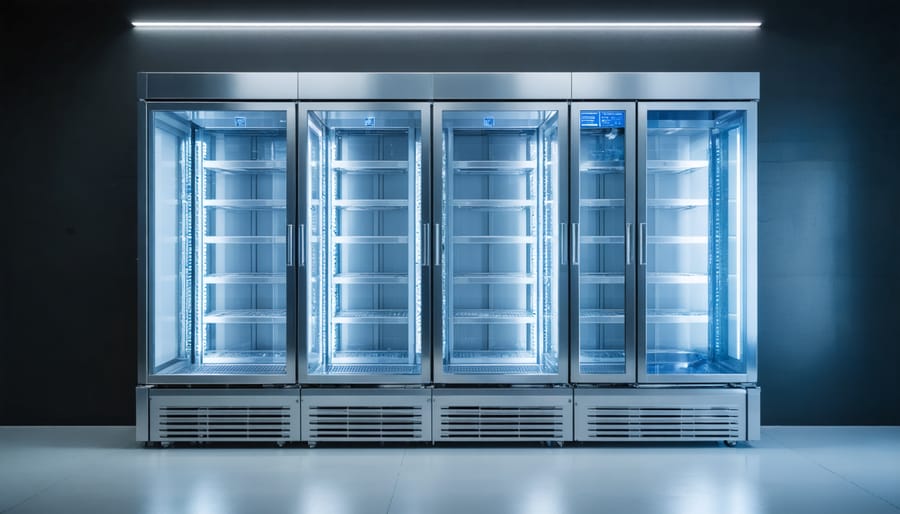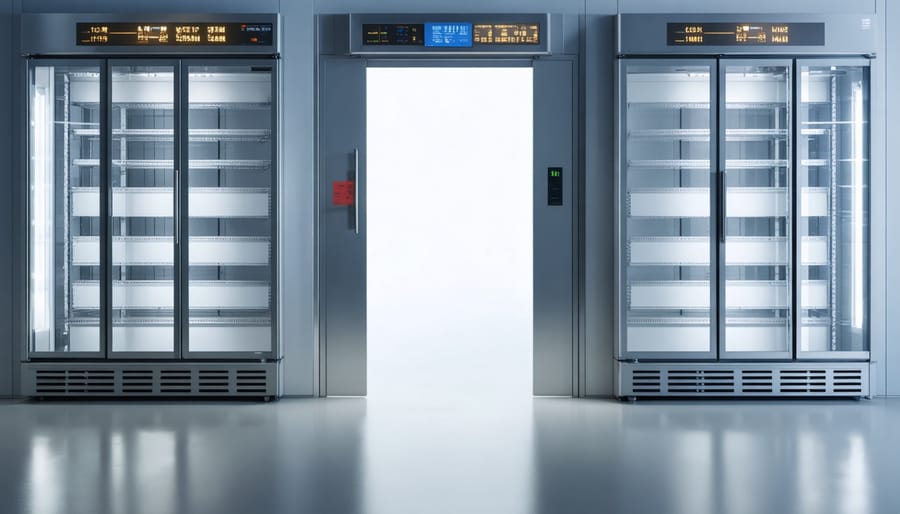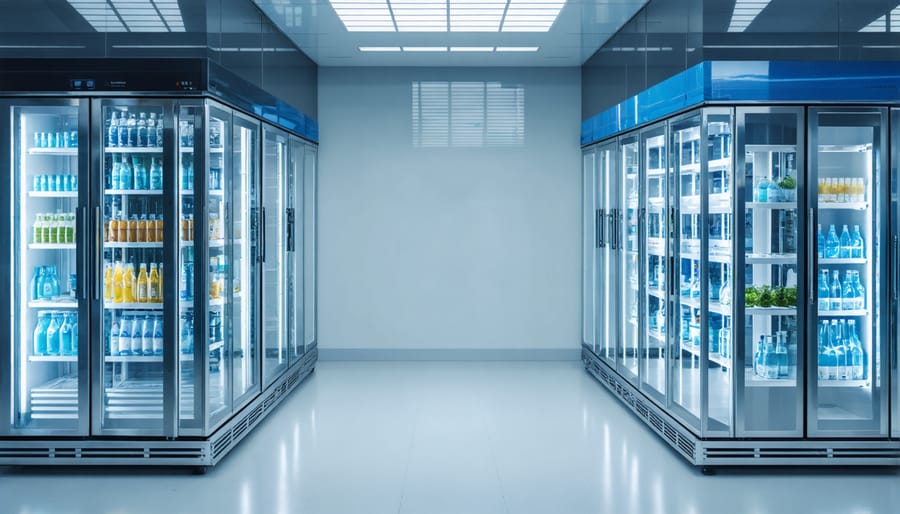Thermal efficiency units represent the cornerstone of modern commercial refrigeration, delivering up to 40% energy savings for Australian businesses while meeting stringent environmental standards. As energy costs continue to rise across the nation, these sophisticated systems have transformed from optional upgrades to essential investments for forward-thinking operations.
By measuring the ratio between useful cooling output and energy input, thermal efficiency units provide precise control over refrigeration performance. In practical terms, this means maintaining optimal food storage temperatures in commercial kitchens while consuming significantly less power than traditional systems. For every kilowatt-hour consumed, modern units deliver measurably more cooling capacity, directly impacting both operational costs and environmental footprint.
The latest Australian-certified thermal efficiency units incorporate smart monitoring systems that automatically adjust performance based on ambient conditions and usage patterns. This intelligent adaptation ensures businesses maintain compliance with food safety regulations while maximising energy efficiency during peak and off-peak periods. From small cafes to large-scale cold storage facilities, these systems offer scalable solutions that align with both sustainability goals and bottom-line objectives.
Understanding Thermal Efficiency Units in Commercial Refrigeration

Key Performance Indicators
When it comes to measuring thermal efficiency, three key indicators stand out in the Australian market: COP (Coefficient of Performance), EER (Energy Efficiency Ratio), and SEER (Seasonal Energy Efficiency Ratio). These metrics help businesses make informed decisions about their cooling systems and compare different options effectively.
The COP tells us how efficiently a system converts energy into heating or cooling. For example, a COP of 3.0 means that for every unit of electricity used, the system produces three units of heating or cooling power. Most modern systems in Australia achieve COPs between 2.5 and 4.0, with higher numbers indicating better efficiency.
EER measures cooling output compared to electrical input at peak conditions, expressed in kW/kW. Think of it as a snapshot of performance on a hot summer afternoon. Meanwhile, SEER takes a broader view, measuring efficiency across different seasons and operating conditions. This makes it particularly relevant for our variable Australian climate, where temperatures can swing dramatically between seasons.
Many Australian businesses now use these metrics to track their system’s performance and identify opportunities for improvement, contributing to both cost savings and environmental benefits.
Australian Energy Rating Standards
In Australia, thermal efficiency standards are governed by the Greenhouse and Energy Minimum Standards (GEMS) Act 2012, which sets mandatory performance requirements for energy efficient appliances including commercial refrigeration units. These standards are designed to reduce energy consumption and greenhouse gas emissions while ensuring optimal performance.
The Energy Rating Label system is a key component of these regulations, using a star rating from 1 to 6 to indicate energy efficiency levels. Commercial refrigeration units must meet minimum energy performance standards (MEPS) to be sold in Australia, with specific requirements varying based on unit type and capacity.
For thermal efficiency units, compliance involves meeting both the Minimum Energy Performance Standards and the Energy Rating Label requirements. Businesses must ensure their refrigeration equipment meets these standards, which are regularly updated to reflect technological advancements and environmental goals. The standards also consider factors like thermal load capacity, insulation effectiveness, and operating temperature ranges specific to Australian climate conditions.
Local certification bodies provide testing and verification services to ensure compliance with these standards, helping businesses make informed choices while supporting national energy reduction targets.
Real-World Impact on Your Business
Energy Cost Reduction
Let’s look at a real-world example from a Sydney supermarket that switched to high-efficiency thermal units. Their monthly energy costs dropped from $4,500 to $3,150 – a remarkable 30% reduction. This isn’t just a one-off success story; similar results are being achieved across Australia.
To calculate potential savings, multiply your current refrigeration energy costs by the efficiency improvement percentage of the new unit. For instance, if you’re spending $2,000 monthly on refrigeration and upgrading to a unit with 25% better efficiency, you could save $500 per month or $6,000 annually.
Many Australian businesses are finding that thermal efficiency units typically pay for themselves within 18-24 months through energy savings alone. A Brisbane warehouse recently reported annual savings of $8,500 after installing new thermal efficiency units, while a Melbourne restaurant cut their cooling costs by 35%.
The savings extend beyond just energy bills. These units often qualify for government energy efficiency rebates and can contribute to your business’s sustainability goals. Local energy providers frequently offer additional incentives for businesses upgrading to more efficient cooling systems, making the initial investment even more attractive.
Environmental Benefits
Installing thermal efficiency units delivers significant environmental benefits that resonate with Australia’s commitment to sustainability. These systems substantially reduce energy consumption, leading to a remarkable decrease in greenhouse gas emissions. For the average commercial facility, implementing thermal efficiency measures can cut carbon emissions by 30-40% annually.
When paired with renewable energy solutions, thermal efficiency units create a powerful combination for environmental protection. They help businesses align with Australia’s climate action goals while setting an example for sustainable operations within their local communities.
The reduced energy demand means less strain on our power grid, particularly during peak summer months when refrigeration systems work hardest. This translates to fewer coal-fired power plants needed to meet cooling demands, directly contributing to cleaner air and reduced environmental impact.
Beyond energy savings, modern thermal efficiency units often use environmentally friendly refrigerants with lower global warming potential. This shift away from harmful substances helps protect our ozone layer and supports Australia’s commitment to phase out harmful refrigerants under international agreements.
By choosing thermal efficiency units, businesses become active participants in Australia’s journey toward a more sustainable future, while inspiring others in their industry to follow suit.
Practical Steps to Improve Thermal Efficiency
Maintenance Best Practices
Regular maintenance is crucial for keeping your thermal efficiency units performing at their peak. Following proper refrigeration maintenance tips not only extends equipment life but also ensures optimal energy efficiency.
Start with a monthly cleaning schedule for condenser coils and filters, as dust and debris can significantly impact performance. In our harsh Australian climate, these components can accumulate dirt more quickly than you might expect. Check door seals quarterly for any signs of wear or damage, as faulty seals are often responsible for unnecessary energy loss.
Monitor temperature settings weekly and keep a log to track any fluctuations. This simple practice has helped many Aussie businesses spot potential issues before they become major problems. Schedule professional maintenance checks at least twice yearly, preferably before summer and winter peak periods.
Don’t forget to inspect and clean drain lines monthly to prevent blockages that could affect unit efficiency. For coastal areas, where salt air can accelerate corrosion, increase the frequency of external component inspections to every three months.
Keep detailed maintenance records and set up automated reminders for routine checks. Many successful Australian businesses have found that creating a maintenance calendar helps ensure nothing gets overlooked, leading to better performance and reduced operating costs.

Smart Technology Integration
Modern thermal efficiency units are increasingly incorporating smart technology to revolutionise how we monitor and manage refrigeration systems. These innovative solutions allow businesses to optimize equipment efficiency through real-time monitoring and automated adjustments.
Australian businesses are embracing Internet of Things (IoT) sensors that provide instant feedback on temperature fluctuations, energy consumption, and system performance. These smart systems can detect issues before they become problems, reducing maintenance costs and preventing food waste.
Many units now feature smartphone integration, allowing facility managers to monitor and adjust settings remotely. Imagine receiving an alert on your mobile when a cool room door has been left open or when temperatures drift outside optimal ranges – that’s the power of smart integration at work.
Advanced analytics platforms can track patterns in energy usage and suggest improvements based on your specific operation. For instance, a Sydney supermarket using this technology reported a 23% reduction in energy costs after implementing AI-driven temperature control.
Local companies are also utilising predictive maintenance algorithms that learn from historical data to forecast when components might need attention. This proactive approach helps maintain peak performance while avoiding unexpected breakdowns, particularly crucial during our scorching summer months.

Staff Training Tips
Training your staff to effectively manage thermal efficiency units is crucial for maximising their performance and longevity. Start by establishing regular training sessions that cover the basics of thermal efficiency and its impact on energy consumption. Ensure all team members understand how their daily actions affect the overall efficiency of your cooling systems.
Create clear, step-by-step procedures for monitoring and recording temperature readings, and teach staff how to spot early warning signs of efficiency problems. Consider appointing “Energy Champions” within your team who can take leadership roles in maintaining optimal thermal performance and sharing best practices with colleagues.
Develop a buddy system where experienced staff members mentor newcomers, focusing on practical demonstrations of proper equipment operation and maintenance routines. Use real-world examples from your facility to illustrate the connection between proper thermal management and cost savings.
Make training materials easily accessible, perhaps through a digital platform or printed guides kept near equipment. Include visual aids like charts showing ideal temperature ranges and checklists for daily monitoring tasks. Regular refresher courses keep knowledge current and provide opportunities to address any emerging challenges.
Don’t forget to celebrate successes when your team achieves efficiency targets. This positive reinforcement helps build a culture of energy consciousness and encourages ongoing commitment to thermal efficiency practices.
Remember, well-trained staff are your first line of defence against energy waste and equipment problems. Their understanding and engagement are essential for maintaining optimal thermal efficiency in your facility.
Australian Success Stories
Across Australia, businesses are leading the way in refrigeration efficiency, demonstrating how smart thermal management can deliver both environmental and economic benefits. Here are some inspiring local success stories that showcase the real-world impact of implementing thermal efficiency measures.
Melbourne-based supermarket chain Fresh Foods Plus achieved a remarkable 40% reduction in their energy costs after upgrading their refrigeration systems with modern thermal efficiency units. Store manager Sarah Chen reports, “We installed smart controllers and monitoring systems across our 12 locations, and the difference was immediate. Not only did we see savings on our power bills, but our produce stays fresher for longer.”
In Brisbane, the family-owned Watson’s Butchery transformed their operations by implementing a comprehensive thermal efficiency strategy. “We replaced our old display cabinets with modern units featuring improved insulation and LED lighting,” explains owner James Watson. “The investment paid for itself within 18 months, and we’re now saving around $15,000 annually on electricity costs.”
Sydney’s Harbor Cold Storage demonstrated the power of combining multiple efficiency measures. Their facility upgraded to high-efficiency compressors, installed automated door systems, and implemented advanced monitoring technology. Operations manager Michael Zhang shares, “Our energy consumption dropped by 35%, and we’ve significantly reduced our carbon footprint. The improved temperature consistency has also resulted in better product quality for our clients.”
Regional success stories are equally impressive. Townsville’s Tropical Fruits Co-op installed solar-powered refrigeration units with thermal storage capabilities, allowing them to maintain optimal temperatures even during power outages. “As a collective of local farmers, we needed a solution that was both environmentally responsible and financially sustainable,” says co-op president Lisa Murray. “The new system has exceeded our expectations on both fronts.”
These examples show that businesses of all sizes can benefit from improved thermal efficiency. The common thread among these success stories is the combination of modern technology, proper system maintenance, and staff training. Many of these businesses also accessed government grants and energy efficiency incentives to help offset initial costs, making their transitions more financially viable.
The journey towards better thermal efficiency in commercial refrigeration is one that every Australian business can embark upon today. By understanding and implementing proper thermal efficiency units, we’re not just cutting costs – we’re contributing to a more sustainable future for our communities and our planet.
From proper insulation and regular maintenance to smart monitoring systems and employee training, every step counts in maximising thermal efficiency. Remember that even small improvements can lead to significant energy savings over time, benefiting both your bottom line and the environment.
As we face increasing environmental challenges and rising energy costs, taking action on thermal efficiency isn’t just an option – it’s a necessity. Whether you’re running a small café in Brisbane or managing a large warehouse in Perth, there’s always room for improvement in your refrigeration systems.
Start by assessing your current setup, consulting with energy efficiency experts, and developing a practical implementation plan. Join the growing number of Australian businesses leading the way in sustainable refrigeration practices. Your journey towards better thermal efficiency starts today, and every improvement makes a difference for tomorrow.
